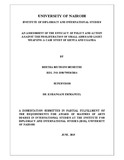| dc.description.abstract | The overall objective of this study is to assess the efficacy of policy and action against the
proliferation of small arms and light weapons with a specific focus on Kenya and Uganda.
This paper argues that improving the efficacy of policy and action in dealing with small arms
is essential to fighting the illicit proliferation of SALW in Africa.
The study highlights the consequences of SALW, and assesses the policy choices and
initiatives at various levels aimed at dealing with the SALW problem. The objective is to
identify gaps that undermine efforts to reduce SALW and also to propose alternative policy
choices. The study will, thus, inform policy makers on threats associated with the illicit
proliferation of SALW and also propose policy options and actions to regulate the spread and
effect of SALW.
The study utilized both primaryand secondary data sources including interviews and material
published in various forms. The study’s running argument is that the proliferation of SALW
tends to escalate and prolong violent conflict. In the end, the study concludes by underscoring
the need fora realistic or coherent political and socio-economic framework that expands on
the traditional concept of “security” - from state security to human security in order to
address the multiple root causes and misuse of SALW proliferation.
The study found a response rate of (60%) - which was considered adequate for further data
analysis. The study found that the participants had a lot of experience and proper understating
of this field, based on their duration of stay in their respective Ministries.
The study notes that (97%) of the respondents had ever heart of the concept of small and light
weapons, in addition, most (98%) were also familiar with the SALW proliferation.
The study concludes that three common approaches define the current thinking on the
relationship between armed conflict and development. The first relates to the expansion of
traditional concepts of “security” a shift from military and state-defined notions of security to
a view that posits “humans”, with their multiple needs and capacities, at the centre of the
picture.
The study recommends a radical review and overhauling of gun legislation by way of greater
cooperation within the four sub-Saharan regional organizations could be very instrumental in
limiting the amount of guns and other SALW in circulation and thus reducing their use. | en_US |

